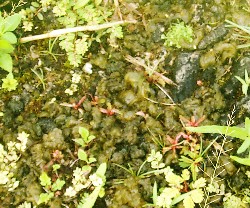SC/SS 115 Ethnobotany Spring 2002
- The sample of green slime from the swamp across the road had the following appearance:

This was also the first sample we examined under the microscope. This is an example of
(circle the letter of the correct answer:
- Archaebacteria
- Cyanobacteria
- Filamentous green algae
- Green eggs in a tube
- Which of the following is the correct Latin binomial (scientific name) for the Hindi
plant "chotachand," the plant that led to the development of modern high blood
pressure medicine?
- Ravolfia
- serpentina
- Ravolfia serpentina
- Apocynaceae Ravolfia serpentina
- What is the local name in your language, if any, for the green slimey stuff found on the
ground and amongst rocks (slimey when wet, hard and black when dried in the sun)?

- Give one reason ethnobotanists tend to study indigenous peoples.
- Margie Falanruw in the Monday 21 January 2002 Pacific Daily News noted that Yapese
culture is fading. Vincent Figir was quoted by the Kansas City Star newspaper as saying,
"The ideal man, in my opinion, would have 50 percent Western knowledge and 50 percent
Yapese knowledge," he said. "There is no Yapese man, no matter how strong his
traditional roots, who is as good as a man who has knowledge of both worlds." This
too implies a loss of knowledge and culture, of change.
- Should cultural knowledge be allowed to pass away?
- Why?
